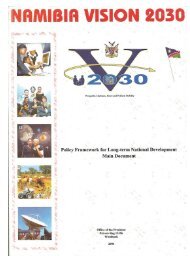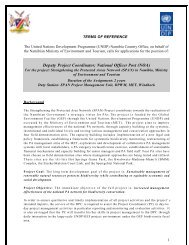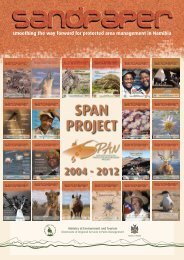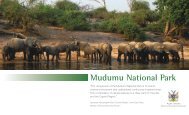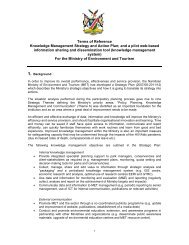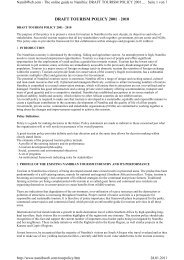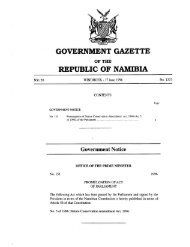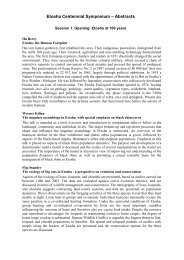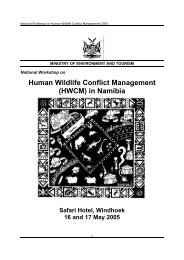EXECUTIVE SUMMARY - Ministry of Environment and Tourism
EXECUTIVE SUMMARY - Ministry of Environment and Tourism
EXECUTIVE SUMMARY - Ministry of Environment and Tourism
Create successful ePaper yourself
Turn your PDF publications into a flip-book with our unique Google optimized e-Paper software.
13<br />
Construction timber. Throughout most <strong>of</strong> northern Namibia, the construction <strong>of</strong> traditional homes<br />
<strong>and</strong> villages is wood-intensive. Very little information is available on the quantity <strong>of</strong> wood used in<br />
construction per year, but it has been estimated that 93% <strong>of</strong> all wood consumption is used for<br />
building<br />
Crafts. This SOER only examines traditional crafts, as opposed to commercial craft production.<br />
Little information exists on the present use <strong>of</strong> natural resources in the traditional craft industry <strong>and</strong><br />
thus there are no reliable data on the impacts <strong>of</strong> natural resource use on the environment.<br />
Furthermore, there is no information on the number <strong>of</strong> people involved in craft production or the<br />
value <strong>of</strong> the industry. All that is known is that there has been a boom in the tourist dem<strong>and</strong> for crafts<br />
over the last decade. The main craft products are: baskets, wood carvings, pottery, bead <strong>and</strong> leather<br />
work <strong>and</strong> jewellery.<br />
Thatching grass. Grass species, mainly Hyparrhenia hirta, are used as a primary ro<strong>of</strong>ing material<br />
on most traditional homes in the northern regions. The dem<strong>and</strong> for thatch for upmarket tourist lodges<br />
has recently led to a number <strong>of</strong> thatching grass enterprises being developed <strong>and</strong> lucrative contracts<br />
signed for annual consignments <strong>of</strong> grass.<br />
Medicinal products. The inherent medicinal value <strong>of</strong> the indigenous plants <strong>of</strong> Namibia is only<br />
recently being understood by city-dwellers <strong>and</strong> multi-national companies. Very little information is<br />
available on the extent <strong>and</strong> value <strong>of</strong> medicinal plant use at present, or the impact <strong>of</strong> increasing<br />
collection on the environment.<br />
Veld foods. Veld foods comprise wild fruits, nuts, berries, leaves, seeds, roots <strong>and</strong> barks which are<br />
collected to supplement diets <strong>and</strong> for beverage making. Use varies spatially <strong>and</strong> temporally across<br />
Namibia according to availability, socio-economic status, agricultural potential <strong>and</strong> yield, cultural<br />
patterns <strong>and</strong> other factors. In rural areas, it is estimated that up to 33% <strong>of</strong> total household food<br />
consumption comes from veld foods. Little is known <strong>of</strong> the value <strong>of</strong> these products in purely cash<br />
terms, but they play an extremely important role in supplementing dietary requirements <strong>of</strong><br />
carbohydrates, proteins, fats, vitamins <strong>and</strong> minerals. However, a limited survey by the CSO in 1995<br />
indicated that the value <strong>of</strong> a few selected wild food products countrywide was in the order <strong>of</strong> N$40<br />
million per annum.<br />
Subsistence hunting. Outside <strong>of</strong> conservancy areas, subsistence hunting is allowed through a permit<br />
system, whereby the MET identifies areas with viable game populations <strong>and</strong> then issues annual<br />
quotas for harvesting to the traditional authorities. The system is loosely controlled <strong>and</strong> wildlife<br />
populations in some areas continue to be decimated at an alarming rate.<br />
The harvesting <strong>of</strong> wildlife within conservancies is still controlled by MET, based on annual quotas,<br />
but the way in which the conservancy members decide to utilise the game i.e. for subsistence or<br />
commercial purposes, is up to them, within the parameters <strong>of</strong> an agreed conservancy environmental<br />
management plan.<br />
In 1994, it was estimated that small-scale (subsistence hunting) in the Caprivi, former Bushmanl<strong>and</strong>,<br />
Opuwo District <strong>and</strong> former Damaral<strong>and</strong>, was only worth about N$119 000, but it has been argued<br />
that moving away from subsistence hunting to non-consumptive tourist operations i.e. preserving the<br />
game rather than killing it, would yield far greater benefits in terms <strong>of</strong> net income, in the order <strong>of</strong><br />
N$13.27 million.<br />
Subsistence fishing. Freshwater fish form a vital part <strong>of</strong> the diets <strong>of</strong> many Namibians, with some<br />
50% <strong>of</strong> the population obtaining half <strong>of</strong> their protein needs from fish (freshwater <strong>and</strong> marine).<br />
Virtually all freshwater fishing in Namibia is artisanal in nature; more than 100 000 people derive<br />
direct or indirect benefits from inl<strong>and</strong> fish resources <strong>and</strong> the fish supply per capita is approximately<br />
10 kg per person per annum. Due to the dearth <strong>of</strong> perennial rivers in Namibia, freshwater fish<br />
resources are limited to the border rivers <strong>and</strong> the wetter, northern areas. The main fishing areas are<br />
W423: SOER on Parks, <strong>Tourism</strong> & Biodiversity: Executive Summary July 2000 13



